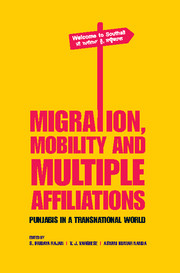Book contents
- Frontmatter
- Contents
- List of Tables and Figures
- Preface
- Acknowledgements
- Transnational World and Indian Punjab: Contemporary Issues
- Part I A Historical Survey
- Part II Shifting Contours of Migration
- Part III Social Structures and Organizational Links
- 8 The Ambiguity of Punjabi Transnationalism: Caste and Development within a Transnational Community
- 9 Punjabi Diasporas: Conceptualizing and Evaluating Impacts of Diaspora–Homeland Linkages
- 10 Punjabi Immigrant Organizations in the UK and their Transnational Connections
- Part IV Education and Migration
- Part V Family Networks
- Contributors
- Index
8 - The Ambiguity of Punjabi Transnationalism: Caste and Development within a Transnational Community
from Part III - Social Structures and Organizational Links
Published online by Cambridge University Press: 05 March 2016
- Frontmatter
- Contents
- List of Tables and Figures
- Preface
- Acknowledgements
- Transnational World and Indian Punjab: Contemporary Issues
- Part I A Historical Survey
- Part II Shifting Contours of Migration
- Part III Social Structures and Organizational Links
- 8 The Ambiguity of Punjabi Transnationalism: Caste and Development within a Transnational Community
- 9 Punjabi Diasporas: Conceptualizing and Evaluating Impacts of Diaspora–Homeland Linkages
- 10 Punjabi Immigrant Organizations in the UK and their Transnational Connections
- Part IV Education and Migration
- Part V Family Networks
- Contributors
- Index
Summary
Introduction
It is widely accepted that there is a long history and deeply embedded cultural tradition of significant overseas emigration from Punjab, India, beginning in the nineteenth century and continuing today. It is a cliché, but also factual, to assert that Punjabis can now be found all over the globe. Partition in 1947 divided Punjab between India (East Punjab) and Pakistan (West Punjab) prior to the political independence of both countries. Most recent estimates of the Eastern Punjabi overseas migrant population settle at around two million (Thandi, 2010). This means that Eastern Punjabis constitute at least 10 per cent of the global Indian diaspora, from a region, which contains only 2 per cent of the Indian population. The focus of this chapter is upon Eastern Punjabi transnationalism. ‘Transnationalism’ generally refers to social relationships across international borders, but it is useful to distinguish between ‘broad’ – global economic restructuring and nation-state transnationalism – and ‘narrow’ – networks of relationships between migrant communities and people and places within an original sending society – transnational social practices (Basch et al., 1994; Itzigsohn et al., 1999) and to recognize that these two phenomena are mutually constitutive (Gardner, 1995; Salih, 2001; Ramji, 2006).
There is, of course, a hugely powerful worldview, put forward by the international financial organizations like the World Bank, International Monetary Fund, World Trade Organization, governments of the G8 countries, transnational corporations and their think-tanks, and the majority of academic economists (e.g., Norberg 2001; Dollar and Kraay, 2002), which sees capitalist globalization (broad transnationalism) as synonymous with ‘development’ in the global south. There are also those who view capitalist globalization as facilitating late modern societies, which are no longer centrally defined by traditional social inequalities (Beck, 1992; Giddens, 1998), while some researchers emphasize the counter-hegemonic potential of narrow transnationalism (Guarnizo, 1994; Portes et al., 1999) and that ‘the overall bearing of transnational activities on sending communities is positive’ (Portes, 1999, 474–75). Some recent studies of Indians (Ballard, 2003; Lessinger, 2003; Singh, 2003) and Eastern Punjabi (Singh and Singh, 2008; Dusenbery and Tatla, 2009; Thandi, 2010) narrow transnationalism predominantly focus upon the relationship between overseas migration and, via international financial remittances, investment in Indian development projects (a process sometimes referred to as ‘diaspora philanthropy’), as well as upon the opportunities for upward social mobility afforded to many in South Asia by the migration networks integral to contemporary Indian transnationalism.
- Type
- Chapter
- Information
- Migration, Mobility and Multiple AffiliationsPunjabis in a Transnational World, pp. 205 - 233Publisher: Cambridge University PressPrint publication year: 2015
- 1
- Cited by



